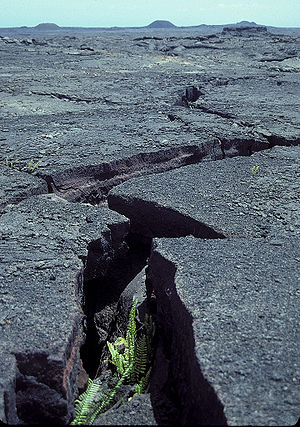
Rift zone
Encyclopedia

Volcano
2. Bedrock3. Conduit 4. Base5. Sill6. Dike7. Layers of ash emitted by the volcano8. Flank| 9. Layers of lava emitted by the volcano10. Throat11. Parasitic cone12. Lava flow13. Vent14. Crater15...
es, especially the shield volcano
Shield volcano
A shield volcano is a type of volcano usually built almost entirely of fluid lava flows. They are named for their large size and low profile, resembling a warrior's shield. This is caused by the highly fluid lava they erupt, which travels farther than lava erupted from more explosive volcanoes...
es of Hawaii
Hawaii
Hawaii is the newest of the 50 U.S. states , and is the only U.S. state made up entirely of islands. It is the northernmost island group in Polynesia, occupying most of an archipelago in the central Pacific Ocean, southwest of the continental United States, southeast of Japan, and northeast of...
, in which a linear series of fissure
Fissure vent
A fissure vent, also known as a volcanic fissure or simply fissure, is a linear volcanic vent through which lava erupts, usually without any explosive activity. The vent is usually a few meters wide and may be many kilometers long. Fissure vents can cause large flood basalts and lava channels...
s in the volcanic edifice allows lava
Lava
Lava refers both to molten rock expelled by a volcano during an eruption and the resulting rock after solidification and cooling. This molten rock is formed in the interior of some planets, including Earth, and some of their satellites. When first erupted from a volcanic vent, lava is a liquid at...
to be erupted from the volcano's flank instead of from its summit. For example, in the currently ongoing eruption of Kilauea
Kilauea
Kīlauea is a volcano in the Hawaiian Islands, and one of five shield volcanoes that together form the island of Hawaii. Kīlauea means "spewing" or "much spreading" in the Hawaiian language, referring to its frequent outpouring of lava. The Puu Ōō cone has been continuously erupting in the eastern...
lava is emitted continuously from the Puu Ōō
Pu'u 'O'o
Puu Ōō is a cinder/spatter cone in the eastern rift zone of the Kīlauea volcano of the Hawaiian Islands...
vent located in Kilauea's East Rift Zone roughly 15 km east of Kilauea Crater. Rift zones tend to extend for tens of kilometers radially outward from the volcanic summit; most Hawaiian volcanoes have two or sometimes three of them. The accumulated lava of repeated eruptions from rift zones causes many Hawaiian volcanoes to have an elongated shape. Perhaps the best example of this is Mauna Loa
Mauna Loa
Mauna Loa is one of five volcanoes that form the Island of Hawaii in the U.S. state of Hawaii in the Pacific Ocean, and the largest on Earth in terms of volume and area covered. It is an active shield volcano, with a volume estimated at approximately , although its peak is about lower than that...
, which in Hawaiian
Hawaiian language
The Hawaiian language is a Polynesian language that takes its name from Hawaii, the largest island in the tropical North Pacific archipelago where it developed. Hawaiian, along with English, is an official language of the state of Hawaii...
means "long mountain".
The origin of the fractures that comprise the rift zones is spreading of the volcano. The more material a shield volcano accumulates, the heavier it gets, and it begins to settle due to the simple effects of gravity. The surface spreads and ruptures.
The reason lava often erupts from the flanks of Hawaiian volcanoes is gravity: it is easier for liquid lava, which is heavy, to flow laterally out the sides of a mountain than to be pushed up an additional several hundred or several thousand meters in elevation to be erupted from the summit. These systems of fissures that make up a rift zone allow this to happen more easily.

